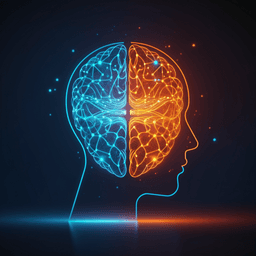
Linguistics and Languages
Shared and distinct neural correlates of first and second language morphological processing in bilingual brain
F. Gao, L. Hua, et al.
This innovative research explores the neural foundations of morphological processing among bilingual individuals, shedding light on how Chinese-English bilinguals utilize their primary language resources for understanding morphology in a second language. Conducted by esteemed researchers including Fei Gao and Lin Hua, this study employs advanced EEG and fNIRS techniques to reveal fascinating insights into bilingual cognitive processes.
~3 min • Beginner • English
Introduction
The study investigates whether adult Chinese–English bilinguals use shared or distinct neural mechanisms for morphological processing in their first language (L1 Chinese) and second language (L2 English). Morphology is central to language comprehension and production, with typological differences across languages (e.g., Chinese as isolating with compounding, English weakly inflectional). Prior ERP work suggests separable morphological and semantic processing (e.g., LAN for structural parsing; early P/N250 for automatic decomposition), and neuroimaging implicates a left fronto-temporal network in morphology. However, bilingual neural correlates remain underexplored, and typological confounds complicate L1–L2 comparisons. Using a shared morphological structure (derivation) and simultaneous EEG–fNIRS during a visual priming task, the authors test the hypothesis that L2 morphological processing largely recruits L1 neural resources (unified competition model), while assessing potential quantitative L1–L2 differences.
Literature Review
Prior ERP studies in German and Chinese show morphological parsing manifests as left anterior negativities (LAN) and semantic processing as N400, with early P/N250 reflecting automatic, form-based morphological decomposition in masked priming. MEG/fMRI work identifies the left inferior frontal and temporal cortices (including STG/MTG) as core regions for morphological processing across languages; Chinese studies particularly implicate left temporal areas in morphological tasks, possibly reflecting morpho-syllabic salience. Bilingual research shows mixed evidence: some language-specific patterns for L1 vs L2 morphology (e.g., L1 Finnish vs L2 Swedish) and growing support for shared mechanisms when structures overlap across languages, consistent with the unified competition model. In bilingual children, differing activations across L1/L2 tasks may reflect structural differences (derivation vs compounding) and proficiency effects. These findings motivate testing shared derivational morphology in adult bilinguals, minimizing typological confounds.
Methodology
Design: Visual morphological priming lexical decision task with simultaneous EEG and fNIRS recording. The task used derivational morphology present in both Chinese and English and contrasted morphological vs semantic priming within each language. Participants judged whether the target word referred to a person (people-related) or not.
Participants: 30 right-handed Mandarin native speakers (15 males; mean age 22.2 ± 3.2 years; age 18–30) from University of Macau; normal or corrected vision; no neurological/psychiatric disorders. English learned at 7.4 ± 2.2 years; no >6 months residence in English-speaking country. LexTALE average 57.21/100 (SD 6.74). IRB-approved; informed consent obtained.
Stimuli: Chinese condition: 60 high-frequency derivational targets (log freq ≈ 1.65) using 6 (semi-)prefixes and 40 (semi-)suffixes; primes were the stems (e.g., 音乐 → 音乐家). Semantic control: 60 compound targets semantically related to primes (no morphological/orthographic/phonological overlap), from Small World of Words. English condition: 60 suffixed targets (e.g., -er, -or, -ness, -ment) from SUBTLEX-US; semantic controls from USF Free Association Norms. Each condition had balanced people-related vs non-people-related targets; familiarity validated (>8.2/9). Semantic association rated and BERT-based semantic distances computed. Materials were vetted for familiarity post-experiment.
Procedure: Block design with 3 runs, 8 blocks per run (2 blocks per condition per run), 10 trials per block (5 people-related, 5 non). Fixation (4 s) separated blocks. Trial: prime 150 ms → mask (50 ms; "**") → target until response or 3000 ms → blank 700 ms. SOA prime-target 200 ms. Participants responded via keyboard to people-relatedness.
EEG acquisition/processing: BrainVision actiCHamp, 32 electrodes, 500 Hz, left mastoid reference; impedances <25 kΩ. Preprocessing in EEGLAB: re-reference to average; 0.01–30 Hz bandpass; epochs −200 to 800 ms around target; ICA to remove eye blinks/line noise; trials exceeding ±100 μV rejected; bad channels interpolated. ERP analyses focused on ELAN (80–150 ms), P250 (200–300 ms), LAN/negativity (300–500 ms). Three-way repeated-measures ANOVAs with factors language (L1 vs L2), priming (morph vs semantic), laterality (left/midline/right), and region (anterior/posterior).
fNIRS acquisition/processing: NIRScout, 8 sources + 8 detectors forming 22 channels over left frontal/temporal cortex; wavelengths 760/850 nm; 7.81 Hz sampling; source-detector distance 3 cm. Channel MNI and overlap with Brodmann areas estimated via 10/20 coordinates and NIRS_SPM. Preprocessing in nirsLAB: 0.01–0.2 Hz bandpass; artifact removal; HbO computed via Beer–Lambert; GLM with canonical HRF to estimate beta values per condition. Two-way repeated-measures ANOVAs (language × priming) per channel; FDR corrections. Pairwise t-tests contrasted morphology vs semantics within language and Chinese vs English within priming type. Behavioral analysis: linear mixed-effects models (lme4) on RT and accuracy with fixed factors language and priming, covariates (people-relatedness, normalized target word length, semantic distance, age of learning English, LexTALE), random intercept for participant; ANOVA for significance.
Key Findings
Behavior
- Accuracy overall 94.90%. Outliers >3 SD RT removed (<1.9%).
- RT: main effect of language (estimate = 126.029, t = 3.721, p < 0.001): Chinese faster than English; main effect of priming (estimate = 20.666, t = 2.864, p < 0.01): morphological faster than semantic; language × priming marginal (estimate = −18.977, t = −1.841, p = 0.066), driven by Chinese: Chinese morphological faster than Chinese semantic (p < 0.01).
- ACC: main effect of language (estimate = 0.578, z = 3.535, p < 0.001): Chinese more accurate; no priming main effect or interaction. Morphological facilitation (semantic − morphological) RT: Chinese 25.8 ± 33 ms vs English −0.7 ± 72 ms (p = 0.06); ACC comparable (p = 0.91).
fNIRS
- ANOVA main effect of language: increased HbO for Chinese vs English at Channel #1 (Frontopolar BA10; F(1,29)=6.902, p=0.0136, partial η²=0.1922), #3 (Frontopolar BA10; F=8.383, p=0.007128, η²=0.224), #19 (Pre-Motor/SMA; F=8.982, p=0.00554, η²=0.236).
- Main effect of priming: Channel #9 (DLPFC; F(1,29)=4.942, p=0.0342, η²=0.146): morphological > semantic; Channels #15 (STG; F=7.843, p=0.008987, η²=0.213) and #16 (STG/MTG; F=8.410, p=0.007046, η²=0.225): semantic > morphological.
- Pairwise contrasts (FDR-corrected):
• Chinese: semantics > morphology in STG/MTG (Ch#15 t=−2.7422, adj p=0.0244; Ch#16 t=−3.1488, adj p=0.0151).
• English: morphology > semantics in DLPFC (Ch#9 t=2.2577, unadj p=0.0317, adj p=0.1267); semantics > morphology in DLPFC/STG/MTG (Ch#15 t=−2.6740, adj p=0.0244; Ch#16 t=−2.5166, adj p=0.0353).
• Morphology Chinese > English in Frontopolar BA10 (Ch#1 t=3.4094, adj p=0.0077; Ch#3 t=2.1866, adj p=0.0740; Ch#4 t=2.9279, adj p=0.0263); Chinese < English in MTG (Ch#17 t=−2.1077, adj p=0.1753, not FDR-significant).
• Semantics Chinese > English in Frontopolar BA10 (Ch#3 t=2.7185, adj p=0.0438).
- Morphological effect (morph − semantic) Chinese vs English: marginal at Ch#10 (DLPFC ~80% overlap), t(29)=1.88, p=0.07 (Chinese > English).
ERP
- ELAN (80–150 ms): main effect of language F(1,29)=41.362, p<0.001, partial η²=0.588; Chinese more negative (−1.2 ± 0.23 μV) than English (−0.52 ± 0.21 μV). Strong anterior and midline distribution. Region × language × priming marginal F(1,29)=3.849, p=0.059: in Chinese, morphology more negative than semantics at anterior sites (−3.80 ± 0.51 vs −3.14 ± 0.44 μV, p=0.03); no priming effect in English (p=0.61). Difference-wave analysis showed marginal language × region (p=0.059): Chinese ELAN morphological effect > English.
- P250 (200–300 ms): posterior positivity > anterior (F(1,29)=10.631, p=0.003, η²=0.263). Region × language interaction F(1,29)=4.997, p=0.033; Chinese more negative than English at anterior sites (p=0.048). Laterality × priming F(2,58)=5.597, p=0.011: in left hemisphere, semantic > morphological positivity (p=0.005). No language effects in difference waves.
- LAN/negativity (300–500 ms): greater frontal negativity than posterior (ps < 0.05), left > right. Region × laterality × priming F(2,58)=9.99, p=0.002: midline fronto-central sites showed more negativity for semantic (−2.33 ± 0.44 μV) than morphological (−1.61 ± 0.53 μV, p=0.013). No language effects in difference waves.
Overall: fNIRS dissociated morphology (left prefrontal/DLPFC) from semantics (left STG/MTG) and showed stronger frontopolar activation for L1 Chinese than L2 English. ERP showed shared early (ELAN) and later (P250, LAN) structural processes across L1/L2, with ELAN magnitude larger in L1 and morphology-specific ELAN in Chinese only.
Discussion
Findings address whether bilinguals share neural resources for morphology across L1 and L2. fNIRS indicates a language-general left prefrontal hub for morphological parsing and a left temporal emphasis for semantic associations, dissociating morphology from semantics. L1 Chinese elicited stronger frontopolar activation than L2 English, suggesting quantitative differences tied to native-ness/proficiency rather than distinct networks, supporting the unified competition model: when structures overlap (derivation), L2 processing recruits L1 neural resources. ERP data show shared temporal signatures (ELAN, P250, LAN) across L1/L2, with ELAN reflecting early structural building active in both languages but larger and morphology-sensitive in L1, consistent with a difference in degree. P250 suggests automatic structural/morphological parsing occurs in both languages, and LAN/anterior N400 reflects controlled evaluation of morphological constraints across L1/L2. Behaviorally, morphological facilitation was evident mainly in L1, aligning with stronger early structural sensitivity in L1. Together, the results underscore shared neurocognitive mechanisms with L1-weighted engagement in adult late bilinguals.
Conclusion
This study combines behavior, EEG, and fNIRS to reveal shared and distinct neural correlates of L1 and L2 derivational morphological processing in adult Chinese–English bilinguals. Morphology engages a left prefrontal network common to both languages, while semantics preferentially recruits left temporal regions. L1 Chinese shows stronger frontopolar activation than L2 English, indicating quantitative differences consistent with proficiency/native-ness rather than distinct qualitative mechanisms. ERP components (ELAN, P250, LAN) demonstrate shared early automatic and later controlled structural processes across L1/L2, with ELAN differences in magnitude. These findings support the unified competition model: for shared structures, bilinguals primarily leverage L1 neurocognitive resources for L2 processing. Future work should include monolingual controls, systematically manipulate proficiency and age of acquisition, and integrate EEG–fNIRS fusion analyses to clarify source–time dynamics.
Limitations
Potential confound from L2 proficiency and late bilingual profile cannot be fully ruled out; no monolingual control groups were included for benchmarking native-ness. EEG and fNIRS were analyzed in parallel rather than integrated, limiting joint spatiotemporal inference. Task materials, while matched by shared derivation, may still differ in language-specific morphological salience; block design could influence strategies.
Related Publications
Explore these studies to deepen your understanding of the subject.







